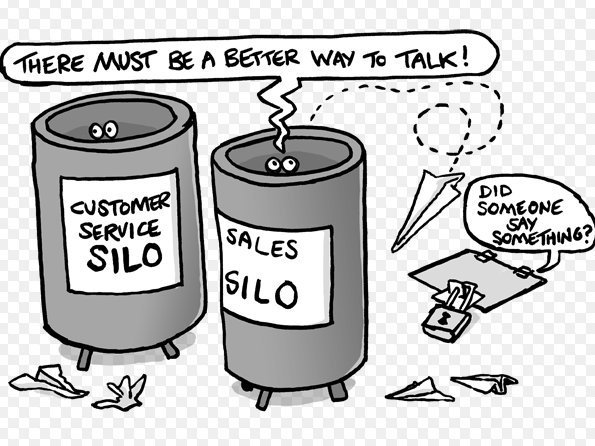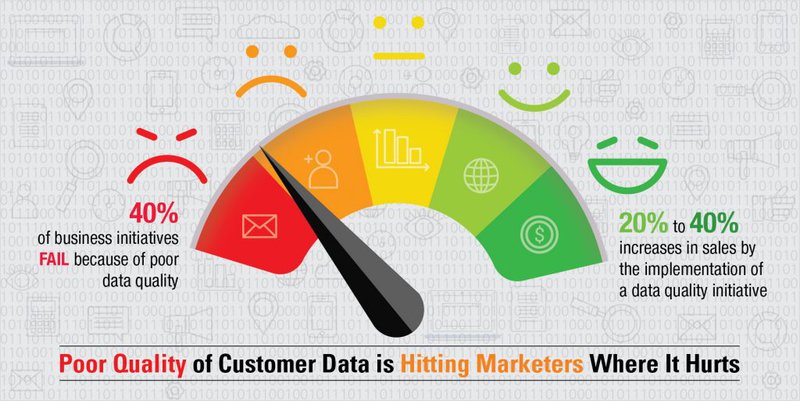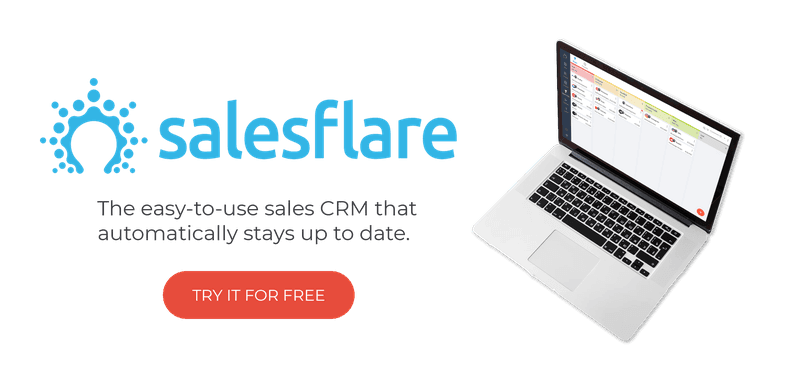Why You Need A Data-Driven Sales Team—And How To Build One
Un blog invité par Josh Brown (Marketing chez Helpjuice)

We’re just gonna come right out and say it:
La vente est un jeu de chiffres.
Hold on, hold on… we don’t mean that in the traditional sense.
(In fact, we’d argue that a wide net, “spray and pray” approach to sales definitely isn’t the way to go by today’s standards.)

What we mean is that, if your goal is to maximize your sales productivity, your first step should be to look to the numbers. This means the myriad data available to your team regarding your customers, your team’s performance, and more.
Votre prochaine étape : plonger la tête la première.
1. Définir l'équipe de vente pilotée par les données
Before we get too far ahead of ourselves, we need to nail down exactly what it means for a sales team to be “data-driven.”
Let’s start with a more overarching (and admittedly vague) definition:
Une équipe de vente axée sur les données est une équipe qui a intégré l'analyse et l'utilisation des données dans tous les processus et activités liés à la vente.
As you might imagine, organizations that have become truly data-driven typically outperform their competition—by a pretty wide margin, too. High-performing sales teams are 3.5 times more likely to have used a data-driven approach than their under-performing counterparts. And companies that have “injected” data into their daily operations are 5% more productive and 6% more profitable than their competition.
Now, there are a few key words we want to call attention to: “integrated” and “injected.” That is, truly data-driven sales teams don’t just “use” data: they find ways to “integrate” and “inject” the data into their daily activities through data transformation. Essentially they put data at the center of everything they do. For such teams, data and hard evidence is never an afterthought. In fact, it’s more often the catalyst that leads the team to make a certain decision or take a specific action.
In this article, we’ll discuss everything that needs to happen for your sales team to become truly data-driven in its everyday operations.
Before we dig in, though, let’s talk about some of the more specific benefits of becoming data-driven.
2. Trois avantages clés de l'orientation vers les données
Comme nous venons de le mentionner, les équipes de vente guidées par les données sont plus productives et plus rentables que leurs concurrents peu performants.
Mais il s'agit en réalité des produits de l'orientation vers les données. Vous devenez plus productif et plus efficace non pas simplement en devenant axé sur les données, mais grâce à ce que l'orientation sur les données vous permet de faire.

Let’s dig a bit deeper into that, shall we?
1. Des processus de vente normalisés (et optimisés)
C'est simple :
Most sales teams and organizations end up wasting a ton of time, money, and energy, because they haven’t truly optimized their various processes.
For starters, sales teams waste a lot of time doing “legwork” rather than actually being productive.

As the image above shows, nearly one-fifth of the average salesperson’s day is spent searching for pertinent information. Not “putting collected data to use”; just searching for it in the first place.
As we’ll get to a bit later on, one of the first steps to becoming data-driven is creating a central data hub that your sales team (and other employees) can access as needed. The easier it is to find the information they need, the quicker your sales team will be able to get to work.
Another issue that comes along with not being data-driven is that you run the risk of wasting resources without even realizing you’re doing so.
Par exemple, Altify a découvert qu'un montant stupéfiant $591 milliards est perdu aux États-Unis (et $1,4 trillion perdu dans le monde) à cause des équipes de vente qui courent après des prospects peu intéressants qui finissent par ne mener nulle part. Cela correspond aux données recueillies par MarketingSherpa montrant que seulement 27% des pistes transmises aux ventes sont en fait des pistes qualifiées en premier lieu.
In such cases, it’s clear that the marketing team’s qualification process differs wildly from the sales team’s processes. Chances are, the data each team is looking at throughout these processes differs just as wildly. Because of this discrepancy, it would simply be impossible for each team to get on the same page moving forward.
However, by centralizing all incoming data (for example, through the use of a CRM)—and collaborating to determine which pieces of information are most vital to a given process—your marketing and sales (and other) teams can begin creating a more systematic approach to creating a funnel that sells.
2. Permet à votre équipe de vente de se personnaliser
En ce qui concerne les relations avec les clients, le fait d'être davantage axé sur les données permet également à votre équipe de vente de s'engager avec les prospects et les clients à un niveau plus individuel.
Comme vous le savez sans doute, cette personnalisation est de plus en plus demandée de nos jours. Selon les données recueillies par Evergage :
- 63% des consommateurs apprécient les marques qui proposent des offres et des contenus personnalisés et pertinents
- 77% des consommateurs choisissent, recommandent et paient davantage pour les marques qui offrent un service plus personnalisé
- 78% ne s'engagent qu'avec des offres adaptées à leurs besoins, sur la base de leur historique avec une marque
For our purposes, here’s the big one: Most consumers are perfectly fine with companies using their private and public data in order to provide them a more personalized experience.
Needless to say, the more data you collect on your prospects and customers—and the more focused you become on what this data actually “means”—the easier it will be for your sales team to engage with them and nurture them toward conversion.
Along with this, a comprehensive collection and understanding of data can take the guesswork out of approaching relatively unknown prospects. For example, in recognizing similarities between a new prospect and your most-valuable customer segment (in terms of persona, behavior, etc.), you’d know exactly what to do at a given point in time in order to get them to convert.
For a prime example of all this in action, look no further than easyJet’s 20th anniversary campaign. Essentially, the travel company used individual customer data, along with automation software, to develop a dynamic email campaign showcasing each customer’s experience with their brand.

The results were nothing short of outstanding. First of all, the team created and sent out over twelve million unique emails—and saw a massive 100% increase in open rates throughout the campaign. What’s more, the campaign earned a 25% higher click-through rate than easyJet’s typical average.
So…yeah. If your goal is to provide a more personalized experience to your audience, your first step should be to go to the data.
3. Dévoilement des principales opportunités
Nous avons vu précédemment comment le fait d'être guidé par les données vous permet de reconnaître et d'éviter les pistes sans avenir, etc.
The other side of all this is that you’ll in turn uncover and recognize a treasure trove of opportunities you may have otherwise overlooked.
Encore une fois, tout se résume à la personnalisation et au fait d'offrir exactement ce qu'un consommateur spécifique souhaite au moment opportun. Quelques exemples :
- Savoir quel(s) produit(s) exact(s) un nouveau prospect pourrait trouver intéressant(s)
- Proposer des ventes incitatives et des offres de ventes croisées aux clients sur la base de leurs achats actuels et passés
- Envoi de rappels et d'offres supplémentaires aux clients récurrents jusqu'à la date moyenne d'achat.
In each of these scenarios, data is at the center of the sales team’s ability to follow through.
Si l'équipe n'accorde pas une grande importance aux données, elle pourrait:
- Lose sales by showcasing products that aren’t best-fit for specific prospects
- Passer à côté de revenus supplémentaires en négligeant les opportunités de vente incitative et de vente croisée
- Risquer de perdre des clients récurrents en laissant leur retour au hasard
Il est évident que vous voulez éviter ces scénarios autant que possible. En vous concentrant sur les données, votre équipe de vente pourra saisir toutes les opportunités qui se présentent à elle.
En fin de compte, devenir plus axé sur les données est tout simplement bon pour les affaires :
- Des processus rationalisés garantissent une efficacité et une utilisation des ressources maximales.
- Des engagements personnalisés conduisent à une augmentation des conversions
- Une meilleure visibilité des données met en lumière les principales opportunités de vente
Maintenant que nous savons tout cela, la question se pose :
Comment pouvons-nous devenir plus axés sur les données au sein de nos propres organisations ?
3. Construire une équipe de vente pilotée par les données
As we made clear earlier, there’s a huge difference between merely collecting and using data in a more surface-level manner, and truly integrating data into your overall operations and processes.
Here, we’ll dive into all that goes into creating a sales team (and overall organization) that is truly driven by data.
Without further ado, let’s dive in.
1. Faciliter un changement culturel et organisationnel
If your team isn’t on board with the shift, it’s simply not going to happen.
Il y a un certain nombre de choses que vous devez faire pour susciter l'adhésion de votre équipe de vente.
First, it’s essential that you frame this discussion in terms of what it means for them. As we talked about earlier, this is all about becoming more productive and efficient—and overall more successful in their efforts as salespeople.
On that same token, it’s also important that you explain why becoming more data-driven will allow your sales team to become more successful. Tap into some of the frustrations your team likely has revolving around data (or lack thereof), such as miscommunication, down time, and wasted opportunities—and show your sales team exactly how a focus on data will help alleviate these pain points moving forward.
Finally, in terms of cultural shift, you’ll want your team to begin operating with a “data first” mindset. That is, your sales team should begin looking to data to inform the next decision they make—not to retroactively rationalize decisions that have already been made. While this might sound like mere semantics, the reality is that taking a “data first” approach to sales will all but ensure your sales team focuses on making improvements that actually matter.
Now, in addition to the cultural and mental shift that must occur throughout your sales team, you’ll also likely need to facilitate a shift in how your sales team interacts with your organization’s other departments.

First, you need to be sure cross-team communication and collaboration is possible, let alone practical. Obviously, if it’s too difficult—or actually impossible—for your sales team to communicate with your marketing and other departments, it’s just not going to happen.
Once cross-team communication is possible throughout your organization, you need to ensure it actually happens—and is done so correctly. Basically, this means systematizing what data and information certain teams are responsible for communicating to whom at certain points in the sales funnel.
We’ll get more into this in a bit, but for now just know that the better your sales and marketing teams communicate, the more aligned they’ll become. By focusing on and communicating the data and information that really makes a difference, each team will gain a more consistent understanding of what a “qualified lead” really is. In turn, your sales team will be able to nurture these high-probability candidates through the sales funnel with relative ease.

Mais, encore une fois, rien de tout cela n'est possible si vous ne facilitez pas le changement dans l'ensemble de votre organisation.
2. Define and Prioritize “Quality” Data
We’ve danced around this topic throughout this article, but let’s lay it right out there:
Part of being truly data-driven is knowing that some data is simply more valuable than other pieces of information. In that same vein, it’s also in knowing how to discern a so-called “vanity metric” from a metric that truly matters to your company’s bottom line in some way or another.
Of course, if you don’t have a specific definition or criteria for what your team considers “quality data,” you’re going to run into problems pretty quickly. As we alluded to earlier, if your marketing team is passing through leads based on one set of data, and your sales team is looking at something completely different, there’s little chance that those prospects will end up converting.

Comme indiqué ci-dessus, un manque d'intérêt pour la qualité des données peut en fait être la raison pour laquelle une entreprise ferme boutique pour de bon. En revanche, les entreprises qui font de la qualité des données ont tendance à connaître une majorité de croissance de leur chiffre d'affaires.
Pour ce qui nous concerne, il y a deux types de données primordiales à prendre en compte :
- Données relatives aux clients
- Données sur les performances des employés et des équipes
In terms of customer-related data, we’re talking about segmentation and persona information, combined with a specific customer’s individual history with your company.
To be sure, each piece of information you collect on a given customer is important in some way or another. However, it’s important to explicitly define and prioritize specific data to be used at given points in time for sales-related purposes. Not only will it ensure consistency between your marketing and sales teams, but it will also ensure your sales team has exactly what they need to make an informed decision regarding a specific prospect.
In defining these data points, you’ll want to consider a variety of questions such as:
- Quelles sont les données collectées par l'équipe marketing que l'équipe commerciale doit connaître ?
- Lors de l'évaluation des prospects, quelles sont les informations sur lesquelles vous devez accorder le plus d'importance ?
- How will having x piece of data affect the sales team’s approach?
We’ve said it before:
Plus vos différentes équipes sont alignées sur les données, plus votre équipe de vente peut être productive.
Speaking of that, the other side of defining “quality” data is in looking at the performance of your sales team overall.
Again, our focus here is on the metrics that truly make a difference to the overall productivity and efficiency of your business. More specifically, we’re looking at data points such as:
- Taux de conversion des prospects: Obviously, a salesperson’s job is to make sales. If their overall conversion rate is relatively low, you’ll need to dig deeper to determine where the leak occurs, and what the problem actually is.
- Durée du cycle de vente: En d'autres termes, plus votre équipe met de temps à réaliser une vente, moins elle a de temps à consacrer à la réalisation des objectifs de l'entreprise. autres sales. Similarly to the above, it’s important to get granular in determining what, exactly, needs to be improved to shorten an all-too-lengthy sales cycle.
- Valeur moyenne des commandes: The probably goes without saying, but the more your sales team can sell at a single time, the better off your business will be. Digging into changes in AOV and other related metrics will give you better insight into what, specifically, presses your target customers’ buying button.
Again, this isn’t to say these are the only metrics that matter; far from it, in fact. The point is that you need to define the metrics that tell a more overarching story about a certain aspect of your business, then dig deeper to decipher the details. The more granular you get, the more information you’ll have on-hand to make improvements in the future.
Vous pouvez suivre ces mesures exactes et bien plus encore en utilisant un CRM comme Salesflare. Consultez notre visite guidée des produits pour plus d'informations.
3. Intégrer les outils et la technologie
Hey, you didn’t think you’d be tracking all this data by hand, did you?
Blague à part, la technologie est essentiellement au cœur de votre capacité à collecter et à utiliser toutes ces informations en premier lieu.
While there are, of course, a plethora of tools and software to choose from to serve your data-driven needs, you’ll at least want to invest in the following:
- Récupérateurs de données sur les clients, tels que Datanyze InsiderLes bases de données de clients vous permettent de collecter rapidement et facilement des informations sur les clients à partir de diverses bases de données. Vous pouvez ensuite analyser la liste collectée en fonction de critères spécifiques pour effectuer des recherches plus approfondies sur les clients.
- Logiciel de gestion de la relation client comme Salesflare make it easy to keep track of customer profiles and track engagements with prospects throughout their personal buyer’s journey. The more information collected and stored within your CRM, the more personalized your sales team’s approach can be.
- Bases de connaissances tels que Helpjuice vous permettent de créer, de stocker et de partager des informations importantes concernant les processus, les produits et d'autres données internes. Vous pouvez également créer des bases de connaissances orientées vers le clientLes clients peuvent ainsi s'engager plus avant avec votre entreprise et tirer davantage de valeur de vos produits.
- Suivi des performances de vente comme Ambition permettent à votre équipe d'évaluer facilement l'efficacité de ses processus de vente aux niveaux macro et micro. En retour, votre équipe peut se concentrer sur des améliorations spécifiques qui lui permettront de fonctionner plus efficacement.
- CDPs or DMPs – other software like a CDP or DMP might also be useful to you. These tools will enable your sales team to have a complete 360 view of customers across all the touch points your business has.
The “best” software for your company depends on your company’s current needs, bandwidth, and other such factors. Before you commit to using any one specific tool or service, make sure you’ve found the one that will integrate most seamlessly into your operations, and that will provide the most value in return.
4. Apporter des améliorations continues
As you can probably tell, shifting toward becoming more data-driven isn’t something that will happen to your sales team overnight.
And, in a sense, it’s not something that ever fully “happens,” at all. That is, there will always be ways for your team to become more data-driven, and to become more efficient and effective in their overall processes, as well.
La bonne nouvelle, c'est que
Plus vous serez axé sur les données, plus il sera facile de le devenir encore plus.
For one thing, once your sales team begins to see the positive impact of becoming more data-driven, they’ll inherently want to dive deeper into this “new way” of doing things. Soon enough, your sales team will begin seeing this “new way” will as the normal and natural mode of operating.
Grâce à l'engagement accru de votre équipe de vente, les améliorations continues font désormais partie intégrante du processus. L'équipe de vente véritablement axée sur les données comprend non seulement l'importance d'injecter et d'intégrer des données dans ses processus, mais elle commence également à réfléchir de manière critique à la meilleure façon de le faire.
As you look to make improvements, you’ll want to think about the answers to questions such as:
- Comment le fait d'être davantage axé sur les données nous a-t-il permis de nous améliorer dans le domaine xyz ?
- Quelles sont les données que nous avons jugées les plus essentielles ou les plus instructives pour améliorer la situation dans le domaine xyz ?
- Quelles autres données ou informations pourrions-nous utiliser pour améliorer le domaine xyz ?
Bien entendu, ces questions ne sont que des points de départ pour aider votre équipe à approfondir un processus ou un domaine spécifique. Il va sans dire que votre ligne d'enquête sera très différente en fonction de votre domaine d'intérêt.
Regardless of your focus, though, with data at the heart of your inquiry, you’ll easily be able to dig up the information needed to make your next steps crystal clear.
Un peu plus sur Josh:
Josh Brown fait partie de l'équipe marketing de Helpjuice. Helpjuice propose des bases de connaissances faciles à utiliser et entièrement personnalisables, conçues dès le départ pour vous aider à développer votre support client et à mieux collaborer avec votre équipe.

Nous espérons que cet article vous a plu. Si c'est le cas, passez le mot !
👉 Vous pouvez suivre @salesflare sur Twitter, Facebook et LinkedIn.
if(window.strchfSettings === undefined) window.strchfSettings = {}; window.strchfSettings.stats = {url: “https://salesflare.storychief.io/data-driven-sales-team?id=1549749501&type=2”,title: “Why You Need A Data-Driven Sales Team—And How To Build One”,id: “b4bf56dd-9b24-4318-a472-b8522fe85e05”}; (function(d, s, id) { var js, sjs = d.getElementsByTagName(s)[0]; if (d.getElementById(id)) {window.strchf.update(); return;} js = d.createElement(s); js.id = id; js.src = “https://d37oebn0w9ir6a.cloudfront.net/scripts/v0/strchf.js”; js.async = true; sjs.parentNode.insertBefore(js, sjs); }(document, ‘script’, ‘storychief-jssdk’))- Fix It Fast - 3 avril 2024
- Save Your Emails - 21 décembre 2023
- Trace Any Relationship - 1er décembre 2023
